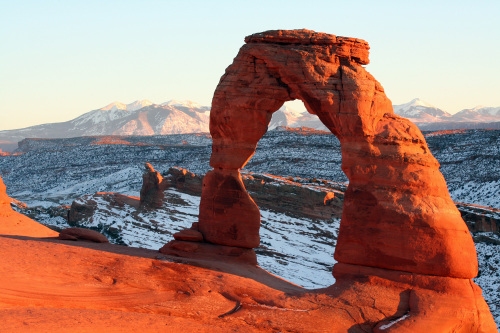ARCHES NATIONAL PARK, Utah ― I spent six hours scrambling across the frosted red rock, eyeing the endless blue above and surrendering to the quiet that commands this place in late January, when the obvious was finally put to me.
“What are you doing out here ― in winter?”
The question came from Kenna Chandler, 31, whom I encountered in the midst of a seven-mile hike through Devils Garden. I’d passed nearly a dozen of the park’s 2,000 red sandstone arches, carved from hundreds of thousands of years of erosion. Some of the arches soared, framing miles of spectacular valley. Others were so minutely hidden, you’d miss them if not for a map.
Much of the year, Devils Garden is a pleasantly demanding trek across well-groomed trails and smooth red rock. In late January, when the rocks and trails are topped with snow and ice, Devils Garden graduates to mildly harrowing. Chandler, who has lived in the area for nine years, had just been reminded of that by losing her footing and sliding three feet down the trail. She rebounded with a smile and told her hiking partner, a bearded man about her age, “Well, I cleared the way for you!”
Now, in 42-degree air, she and that guy rested in the crook of Double O Arch ― one arch atop the other, hence Double O ― munching apples and nuts. And Chandler wanted to know what brought me here in its coldest, quietest month. It’s so quiet that in Moab, the hub of tourist activity five miles south, some hotels were closed for the season. (The brewery, fortunately, was not.)
I told her: I wanted to see Arches in winter. I wanted to see its roads unclogged and its red rocks glazed with snow. I had wondered if they looked different this time of year and found a resounding and rewarding answer: yes.
Topped wi
“What are you doing out here ― in winter?”
The question came from Kenna Chandler, 31, whom I encountered in the midst of a seven-mile hike through Devils Garden. I’d passed nearly a dozen of the park’s 2,000 red sandstone arches, carved from hundreds of thousands of years of erosion. Some of the arches soared, framing miles of spectacular valley. Others were so minutely hidden, you’d miss them if not for a map.
Much of the year, Devils Garden is a pleasantly demanding trek across well-groomed trails and smooth red rock. In late January, when the rocks and trails are topped with snow and ice, Devils Garden graduates to mildly harrowing. Chandler, who has lived in the area for nine years, had just been reminded of that by losing her footing and sliding three feet down the trail. She rebounded with a smile and told her hiking partner, a bearded man about her age, “Well, I cleared the way for you!”
Now, in 42-degree air, she and that guy rested in the crook of Double O Arch ― one arch atop the other, hence Double O ― munching apples and nuts. And Chandler wanted to know what brought me here in its coldest, quietest month. It’s so quiet that in Moab, the hub of tourist activity five miles south, some hotels were closed for the season. (The brewery, fortunately, was not.)
I told her: I wanted to see Arches in winter. I wanted to see its roads unclogged and its red rocks glazed with snow. I had wondered if they looked different this time of year and found a resounding and rewarding answer: yes.
Topped wi

th unsullied white, southern Utah’s red rocks seem even redder. The thrill is in the contrast, especially at sunset, when the rocks turn a warm orange-red and the snow, reflecting the fading sun, becomes softly rosy. Add short, scrubby green grasses and the sky’s piercing blue, and Arches National Park sings in winter ― albeit to a small audience. Which makes it even better, as Chandler had long known.
“Summer tourists ask all the time what it’s like in winter,” she said. “Not too many come to see it. This is our time to explore.”
Winter travel most often calls to us in the form of beaches and ski hills, with little in between. It leaves places such as Arches attracting one-tenth of the traffic in December and January that it does in June and July. In winter, Arches’ trail signs directing motorists to overflow parking are laughable. No one is here but locals (that is, people from within 500 miles) and foreigners (I met Russians, Germans, Australians).
I usually would have finished the seven miles through Devils Garden in three or four hours. In January it took nearly six. Yes, going was slowed on the snow and ice, but a combination of sheer beauty ― the twisting, soaring red rock is unrivaled ― and solitude made me linger. When no one bothers you for 30 minutes while staring through Partition Arch at a still, snow-covered valley, there’s no reason to leave.
In the age of cellphones and music wherever you go, it took awhile to realize that the solitude also meant quiet. Slowly I noted bird trills. I heard a low-passing raven’s wings cut through the mountain air. And I heard nothing; in the deepest reaches of Devils Garden, looking at the land unfold 100 miles in every bright direction, I heard only me: the wind in my ears, my breath, a click in my jaw. There was nothing else to hear. Only see.
Of course, Arches in winter is not a completely solitary escape. One evening just before sunset, some chattering girls in their early 20s milled about Delicate Arch while the park’s most iconic symbol ― it is on the state license plate ― turned a dusky, rosy orange. But no problem; I waited them out until being left alone with that grand, muscular arch and just a couple visiting from Germany.
In the quiet, the woman, Rejina Zollmann, 48, gave her husband, Karl, 56, a play-by-play of the colors evolving before our eyes.
“Look, now it’s like an orange,” she said. “Now it’s turning bright red!”
It was their sixth time at Arches and their second in winter. It’s the time of year they prefer being there.
“If you come in winter you’ll never come again in spring or fall,” Zollmann said. “If mankind doesn’t believe in God or a higher force, they should come here with open eyes and an open heart and they can understand.”
She paused.
“I’m not American,” she said. “I can’t explain it.”
I told her she explained Arches’ quiet winter beauty well ― better than many Americans could. But then the sun slipped over the ridge, and the first star blinked through the dusky sky. I shook the Germans’ hands, said goodbye and started the three-mile walk back to my car. I wanted nothing to do with those icy trails in the dark.
By Josh Noel
(Chicago Tribune)
(MCT Information Services)
“Summer tourists ask all the time what it’s like in winter,” she said. “Not too many come to see it. This is our time to explore.”
Winter travel most often calls to us in the form of beaches and ski hills, with little in between. It leaves places such as Arches attracting one-tenth of the traffic in December and January that it does in June and July. In winter, Arches’ trail signs directing motorists to overflow parking are laughable. No one is here but locals (that is, people from within 500 miles) and foreigners (I met Russians, Germans, Australians).
I usually would have finished the seven miles through Devils Garden in three or four hours. In January it took nearly six. Yes, going was slowed on the snow and ice, but a combination of sheer beauty ― the twisting, soaring red rock is unrivaled ― and solitude made me linger. When no one bothers you for 30 minutes while staring through Partition Arch at a still, snow-covered valley, there’s no reason to leave.
In the age of cellphones and music wherever you go, it took awhile to realize that the solitude also meant quiet. Slowly I noted bird trills. I heard a low-passing raven’s wings cut through the mountain air. And I heard nothing; in the deepest reaches of Devils Garden, looking at the land unfold 100 miles in every bright direction, I heard only me: the wind in my ears, my breath, a click in my jaw. There was nothing else to hear. Only see.
Of course, Arches in winter is not a completely solitary escape. One evening just before sunset, some chattering girls in their early 20s milled about Delicate Arch while the park’s most iconic symbol ― it is on the state license plate ― turned a dusky, rosy orange. But no problem; I waited them out until being left alone with that grand, muscular arch and just a couple visiting from Germany.
In the quiet, the woman, Rejina Zollmann, 48, gave her husband, Karl, 56, a play-by-play of the colors evolving before our eyes.
“Look, now it’s like an orange,” she said. “Now it’s turning bright red!”
It was their sixth time at Arches and their second in winter. It’s the time of year they prefer being there.
“If you come in winter you’ll never come again in spring or fall,” Zollmann said. “If mankind doesn’t believe in God or a higher force, they should come here with open eyes and an open heart and they can understand.”
She paused.
“I’m not American,” she said. “I can’t explain it.”
I told her she explained Arches’ quiet winter beauty well ― better than many Americans could. But then the sun slipped over the ridge, and the first star blinked through the dusky sky. I shook the Germans’ hands, said goodbye and started the three-mile walk back to my car. I wanted nothing to do with those icy trails in the dark.
By Josh Noel
(Chicago Tribune)
(MCT Information Services)
-
Articles by Korea Herald



![[Exclusive] Korean military set to ban iPhones over 'security' concerns](http://res.heraldm.com/phpwas/restmb_idxmake.php?idx=644&simg=/content/image/2024/04/23/20240423050599_0.jpg&u=20240423183955)

![[Graphic News] 77% of young Koreans still financially dependent](http://res.heraldm.com/phpwas/restmb_idxmake.php?idx=644&simg=/content/image/2024/04/22/20240422050762_0.gif&u=)



![[Pressure points] Leggings in public: Fashion statement or social faux pas?](http://res.heraldm.com/phpwas/restmb_idxmake.php?idx=644&simg=/content/image/2024/04/23/20240423050669_0.jpg&u=)










